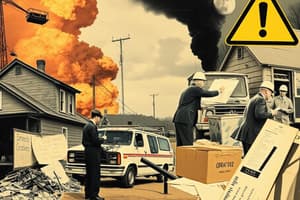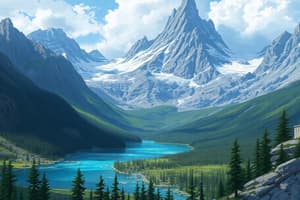Podcast
Questions and Answers
Which area in Canada is most prone to earthquakes?
Which area in Canada is most prone to earthquakes?
- Newfoundland
- Southern Ontario
- The Prairies
- British Columbia (correct)
Tornadoes in Canada mainly occur in British Columbia.
Tornadoes in Canada mainly occur in British Columbia.
False (B)
What climatic conditions lead to the formation of tornadoes in Canada?
What climatic conditions lead to the formation of tornadoes in Canada?
Warm, moist air from the Gulf of Mexico meets cold, dry air from the Arctic.
Ice storms are particularly prevalent in __________ Canada.
Ice storms are particularly prevalent in __________ Canada.
Match the natural disaster with its main trigger:
Match the natural disaster with its main trigger:
Which landform region in Canada is characterized by rolling hills and is known for its agriculture?
Which landform region in Canada is characterized by rolling hills and is known for its agriculture?
Human-environment interaction only refers to negative impacts on the environment.
Human-environment interaction only refers to negative impacts on the environment.
What is the primary purpose of the Prime Meridian in geography?
What is the primary purpose of the Prime Meridian in geography?
The _____ plate boundaries are where tectonic plates collide.
The _____ plate boundaries are where tectonic plates collide.
Match the following types of natural disasters with their primary causes:
Match the following types of natural disasters with their primary causes:
Flashcards
Earthquakes
Earthquakes
A geological event where the Earth's tectonic plates shift and release energy, causing ground shaking.
Tornadoes
Tornadoes
Powerful rotating columns of air that form within severe thunderstorms. They can cause significant damage due to their high winds.
Landslides
Landslides
A mass of rock, soil, and debris that slides down a slope, often triggered by heavy rainfall, snowmelt, or earthquakes.
Ice Storms
Ice Storms
Signup and view all the flashcards
Spatial Significance
Spatial Significance
Signup and view all the flashcards
Human-Environment Interaction
Human-Environment Interaction
Signup and view all the flashcards
Absolute Location
Absolute Location
Signup and view all the flashcards
Landform Regions
Landform Regions
Signup and view all the flashcards
Tectonic Plates
Tectonic Plates
Signup and view all the flashcards
Glaciation
Glaciation
Signup and view all the flashcards




